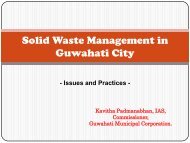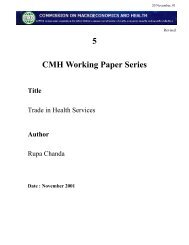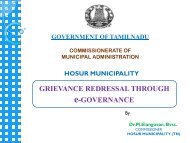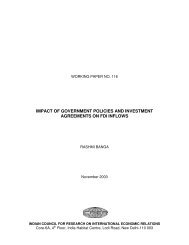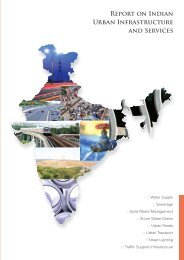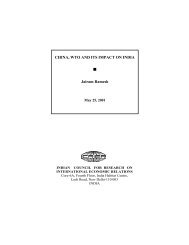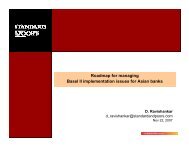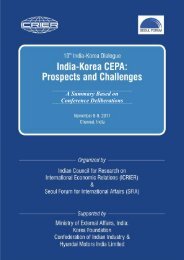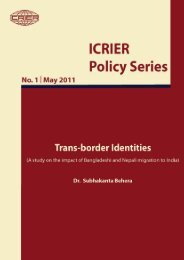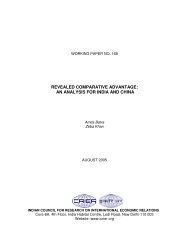Asia's Arc of Advantage - icrier
Asia's Arc of Advantage - icrier
Asia's Arc of Advantage - icrier
Create successful ePaper yourself
Turn your PDF publications into a flip-book with our unique Google optimized e-Paper software.
Korea were invited to be part <strong>of</strong> the ASEM partnership, which indicated the probable emergence<br />
<strong>of</strong> ASEAN + 3 based regional frameworks. However, it was the Asian Financial Crisis (AFC),<br />
in 1997, which had a pr<strong>of</strong>ound impact on thinking pertaining to East Asian Regionalism.<br />
The rapid spread <strong>of</strong> the financial crisis demonstrated to the East Asian countries the scale <strong>of</strong><br />
interdependence amongst their ranks and the need for collaborative action. There was a strong<br />
opinion among them that the IMF and the US exacerbated the crisis, misdiagnosing its causes<br />
and <strong>of</strong>fering inappropriate solutions. 20 For instance, IMF conditions such as spending cuts,<br />
tax increases, bank closures and tight monetary policy in return for a loan <strong>of</strong> $10 billion to<br />
Indonesia resulted in the contraction <strong>of</strong> the Southeast Asian economy by 13 per cent in 1998. 21<br />
As a consequence, the Asian Financial Crisis generated deep suspicion <strong>of</strong> global institutions<br />
such as the IMF and the role <strong>of</strong> the US in East Asia came under greater critical scrutiny.<br />
In this context, there were apprehensions that China would devalue its currency, resulting in<br />
Chinese exports becoming cheaper in international markets, thus prompting further currency<br />
devaluation across East Asia and plunging the region into a deeper financial crisis. 22 Instead,<br />
China refrained from devaluing its currency and instead mobilised its foreign currency reserves<br />
to assist countries in the region, thereby facilitating the stabilisation <strong>of</strong> regional economies. 23<br />
These actions were appreciated by Southeast Asian countries. It was this dual dynamic –<br />
the demonstration <strong>of</strong> intense interdependence by the AFC and the failure <strong>of</strong> international<br />
institutions to respond effectively – that prompted the countries in East Asia to look at ASEAN<br />
+ 3 frameworks even more closely.<br />
It was in December 1997 that the first ASEAN + 3 Summit was held in Kuala Lumpur, Malaysia,<br />
and the areas <strong>of</strong> APT co-operation have since expanded and deepened over the years to include<br />
food security, energy security, the environment and sustainable development. 24 However, the<br />
core <strong>of</strong> ASEAN + 3 has been financial co-operation.<br />
On May 06, 2000, the finance ministers <strong>of</strong> the ASEAN + 3 came together in Chiang Mai, Thailand,<br />
to explore possibilities <strong>of</strong> greater financial consolidation. The ministers stated their intention<br />
to co-operate on monitoring capital flows, to establish a regional financing arrangement to<br />
supplement existing international facilities, and to establish a network <strong>of</strong> research and training<br />
institutions. 25 More importantly, they announced the Chiang Mai Initiative:<br />
20 Richard Stubbs, “ASEAN Plus Three: Emerging East Asian Regionalism?” Asian Survey, May/June 2002, Vol.<br />
XLII, No.3.<br />
21 Analysis: Aid Recipients Welcome IMF’s Shift on Austerity,” Reuters, October 14, 2012, available at http://<br />
www.reuters.com/article/2012/10/14/us-imf-aid-admission-idUSBRE89D0GQ20121014.<br />
22 Wayne M. Morrison, “China’s Response to the Global Financial Crisis: Implications for U.S. Economic<br />
Interests,” CRS Report for Congress, ... available at http://congressionalresearch.com/98-220/document.php<br />
?study=CHINAS+RESPONSE+TO+THE+ASIAN+FINANCIAL+CRISIS+IMPLICATIONS+FOR+U.S.+E<br />
CONOMIC+INTERESTS.<br />
23 Ming Xia, “ “China Threat” or a “Peaceful Rise <strong>of</strong> China”?” The New York Times, available at http://www.<br />
nytimes.com/ref/college/coll-china-politics-007.html.<br />
24 “Overview: ASEAN Plus Three Cooperation,” ASEAN, October 23, 2012, available at http://www.asean.org/<br />
asean/external-relations/asean-3/item/asean-plus-three-cooperation.<br />
25 “The Joint Ministerial Statement <strong>of</strong> the ASEAN + 3 Finance Ministers Meeting, May 6, 2000, Chiang Mai,<br />
Thailand,” Ministry <strong>of</strong> Foreign Affairs, Japan, available at http://www.m<strong>of</strong>.go.jp/english/international_policy/<br />
convention/asean_plus_3/20000506.htm.<br />
72 | Asia’s <strong>Arc</strong> <strong>of</strong> <strong>Advantage</strong>



